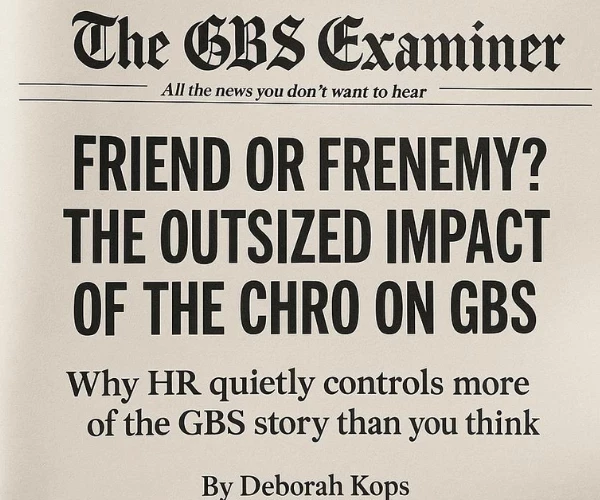Shared Services Industry Recalibrates at SSO Week Orlando
Add bookmark
SSO Week North America: Reassurance or Terror?
For anyone who does not know, SSO week both reassures and terrifies in equal measure. Reassures, because there are plenty of opportunities to benchmark informally and confirm you are on the right track; and terrifies, because it's full of disruptive and explosive ideas that are happening right now! (And you appear to be missing out.)
Last week in Orlando's wonderful and colorful Coronado Springs Disney resort, the adrenaline spike came from technology and, perhaps, a certain missing ‘culture’. There were three separate sessions on blockchain alone (compare that to it featuring nearly as a mere footnote a year ago). And if you consider that the rarefied house of Chanel is running a blockchain pilot for intercompany transactions, that pretty much tells you everything you need to know about which way the wind is blowing!
But before we dive into blockchain, Brad DeMent, chairman of the Week (and himself from the rarified house of ScottMadden), provided much needed context in his opening address by reminding us of the three factors that determine performance and success:
- delivery model
- technology, and
- people/customers.
Everything we do is about impacting at least one of these factors, he reminded user. Many organizations are planning to leverage the global process ownership and standardization of a GBS, he pointed out (SSON Analytics predicts 30% of global Shared Services will adopt GBS within the next five years, in addition to the 1/3 already operating as such). In addition, two thirds of shared services have already deployed a Center of Excellence.
These kinds of initiatives, Brad reminded us, are difficult to quantify in terms of payback. There's no obvious FTE-metric to track. The guiding light, however, is the “Amazonification” of orders. At any given time today’s customer wants to know where in the value chain a given process is. Visibility and collaboration for problem solving are key. And, with ScottMadden predicting that 30% of all HR work and 40% of all F&A work can be automated, the impact of technology on business services is nothing short of extraordinary.
So, where does all of this leave us?
Blockchain
Let’s start with blockchain. It’s a technology still little understood and even less prepped for, but last week provided a number of opportunities to change that. First up was Gerard Dache from the Government Blockchain Association, who set the scene by warning us that blockchain is not only moving very fast, but billions of dollars are already passing through it, and 40% of all college students are already trading in bitcoin – one of the first examples of blockchain technology (by the way, it takes only nine lines of code to create a new digital currency!). But Gerard also reassured us. The peer-to-peer transactions environment enabled by blockchain frees us up from being beholden to government institutions, he said; and no single entity controls nor is accountable for blockchain – instead, 15,000 computers world-wide check and verify. In addition, it promises certainty and security; and blockchain "cash" cannot ever be used twice so fraud is impossible. It’s growing so fast, he said, because blockchain enabled trade cuts out the middleman, and thereby supports faster and cheaper transactions.
Find out who won the SSON Impact Awards 2019! More
While Gerard offered a broad intro, it was left to Bettina Warburg of Animal Ventures to make us feel that we, too, can do it. The reason blockchain works, she explained, is because it reflects the age-old demand for certainty as a prerequisite for trade. With decentralized technologies changing the way we conduct business, blockchain replaces the old-fashioned check, which was nothing more than a contract backed by a bank. The carbon copy stack of used checks, she explained, was proof of our transactions. These carbon stacks are today represented by a digital block (as in blockchain) – A stack of data linking to all previous transactions. Without the banks standing in between to reassure us of our trading partners’ validity, blockchain is just another way of lowering uncertainty.
Blockchain’s “awesomeness”, Bettina explained, also derives from being built on smart contracts. These contracts link to unique digital identifiers and have a significant potential for the supply chain, for example. This is relevant to business services because every asset (or service) has a supply chain – a story of transactions linked over time.
So far, so good.
While the obvious use case might be in procurement and supply chain, Deborah Lim from Chanel explained that she was running a pilot on inter-company transfers. This exploratory work is simply a continuation of the company’s interest in learning about emerging automation opportunities like RPA, she explained. It wasn't too long ago, Deborah reminded us, that the Internet and email were foreign concepts (see below for a REMINDER) met with suspicion and resistance by almost all. Blockchain may be just the same, so Chanel wants a head start.
For Finance, the fact that smart contracts underpin blockchain and that it is tamperproof and easily verifiable are attractive features. As Deborah runs Chanel’s global process solutions, it presented a good opportunity to test intercompany transfers. It’s still far too early to draw conclusions, she said, but early learnings are that you need a specific kind of skill set in your technology consultant – someone who understands the business and who can translate it into techno-speak. It's also a more expensive pilot than automation because nothing comes "out-of-the-box". And the challenge is to be able to clearly define what you expect to get out of blockchain, in order to gain funding.
More to come.
Process mining
As Shared Services leaders have successfully managed the standardization and governance part of the model, we are now seeing a shift to re-thinking the process itself, via Process Design.
Numerous sessions on this topic highlighted not just the "process discovery" and “mining” aspect of process evaluation that so cleverly and visually highlights the bottlenecks that can be solved with RPA, but also the opportunities that variances identify. Deviations indicate some kind of waste, we were reminded, so tracking these deviations is critical for any center that has performance excellence in its DNA.
Get Chairman Brad DeMent's popular conference takeaways and highlights. More
Robert Bradford of AkzoNobel explained the company’s robust approach and methodology that combines process mining with continuous improvement to great effect. Within seven days of the end of the month, his team identify, through process mining, the top five opportunities in an end-to-end process and raise it with the GBS team, which then has a month to rectify these gaps before the next cycle kicks in. All the metrics tracked are tied back to “the golden rules” of end-to-end processing, Robert explained. GBS effectively finds “signals in the noise” using process mining. And while in the past this type of research was more or less a guessing game, today value stream mapping provides transparency.
Design thinking
An excellent section of the program covered design thinking across in a couple of different sessions and tracks. The idea here is to start with the objective and consider whether an alternative to the status quo process might achieve this objective more effectively, as the Canadian Tire Company’s team explained in introducing how user-centric design was embraced to support continuous improvement.
The lesson with design thinking is that what you think the stakeholder wants is not always what the stakeholder really wants. One session leader suggested starting with empathy – and then designing and validating the problem statement against your customer’s interpretation. User-centered design smooths the bumpy edges of a process as it recalibrates itself based on the user’s experience. Agility and responsiveness are key traits.
A common impediment is budget, explained one of the speakers, but rather than worry about where the funding will come from, get the project to the table first, she advised. Desirability should drive 80% of the design; only 10% should be dictated by feasibility and viability. That is how you get maximum creativity.
The other factor is to consider the different personas that processes touch, and what they want. HR may need quality staff on time, but finance is looking for low cost. So how do you move forward?
I’d encourage anyone with a spare 22 minutes to watch this video on how design team IDEO – one of the most influential product development firms in the world – faced the challenge presented by ABC News to come up with a new design for a shopping cart. It's completely different, completely inspirational – and somewhat wild. But that might be where your next great idea comes from. Imagine hovering around your customers’ desks and snapping pictures of them using your services. That’s what we are talking about. The take away: "Enlightened trial and error succeeds over the planning of the lone genius".
Business Process Outsourcing
As an industry, we haven't focused on BPO for a while with so many new and exciting bells and whistles to play with (AKA RPA). But BPO is a significant and still relevant part of service delivery. A number of speakers espoused a champion/challenger model whereby tier 1 BPO partners were matched with specialist, smaller outsourcing specialists in a so-called "Frankenstein" approach. True value derives from those partners that understand the business, they confirmed, and how that relationship evolves. In fact, in fast-growing organizations one of the few stable factors are the outsource providers, who tend to survive the various strategy reboots!
Disruptive technologies
Disruption is really where it's at, and there is no better person to explain what's what to us than Tony Saldanha, previously head of Procter & Gamble's Next Generation Services team in the company’s much-admired GBS. Tony exhorted us all to think big and think free. And with reference to IBM’s collaboration with Maersk to move all supplier and customer information onto blockchain, he challenged us to consider a future where there will be no need for invoices as organizations self-invoice via blockchain.
However, don’t try and do everything yourself, he warned. Instead, leverage your ecosystem and the thousands of startups out there. Venture capitalists are a great resource for connecting with tech startups, he suggested. In addition, Tony exhorted those present to use their vendor ecosystems to scale up innovative solutions. They have the capacity and can easily be incented, he advised. The challenge in falling behind is not just that you lose your competitive edge, Tony warned, but that as technology grows exponentially and organizations tend to grow linearly, you won't ever catch up.
Global Business Services
SSON Analytics data tells us that a third of centers worldwide are already running GBS, and another 30% plan to move to the model within five years. GBS models at this conference came in different shapes, sizes and industries. In an exciting panel discussion, UPS’s Suzanne Leopoldi-Nichols outlined the 16,000 staff within her GBS that operate across 88 centers; while at Silicon Valley Bank, Steven Jo ran a “GBS" that is much smaller but fighting hard to keep up with the company’s 300% growth in just over a decade. His team is under pressure to keep up with Silicon’s customers’ extraordinary rate of growth, he explained, which is pushing up costs and has driven a completely different conversation around scalable growth and employee enablement. It's really about the customer experience rather than cost, Steven emphasized.
In the face of all the challenges a modern enterprise encounters the trick is to stay relevant. Multiple speakers confirmed they were constantly looking to add value to their customers in new ways, and that continuous improvement was an effective strategy – in particular, combined with predictive modeling.
‘Digital’ provides a unique opportunity to GBS today (read this article on Digitalized GBS) and adds to customer experience as well as to both top and bottom lines. The end goal is a one-office approach, agreed a panel titled ‘Digital BPM’, where the lines between front and back office blur, and back office insights are seamlessly leveraged in the front office.
Tying GBS to business imperatives is the critical part that many centers have not yet grasped. At McDonald's, Debbie Ballard’s GBS scope incorporates finance, people, and operational excellence (the latter includes change management). Debbie has identified three game changers for GBS to support McDonalds: driving and leading the culture of continuous improvement; digitizing through intelligent automation; and modernizing the customer experience. Continuous improvement supports agility, which is a business imperative today. (While 10-years used to be acceptable in planning restaurant overhauls, today it’s three or less.) Performance is driven by ‘moments that matter’ as opposed to ‘standardization’; GBS is being upskilled with new training; and legacy systems are being updated to modernize the customer experience.
Finally, just before we all took off: "Orlando, we have a problem!"
A fitting summary and conclusion to the week was offered by Deborah Kops, the first lady of the industry. (For those of you who don't know her, look her up on LinkedIn. She’s “living proof that boomer girls can do neat things.”) Deborah focused in on GBS for her closing session, acknowledging that while there was strong interest in the model, there is still a lot to be worked out. It's not "should we" but "how do we" work GBS, she said. The trouble is there is still too much servant positioning, with GBS focused on what the parent company does not want to do. In addition, GBS leaders are still 3 to 4 levels removed from the CXO, and its capabilities are aging – most still offer just one channel of delivery and don’t reflect the disruption that is impacting the workforce. And finally: Insufficient ambition means that incremental improvements are deemed good enough.
So, she admonished those present, aim higher! Stop dreaming about transformation but then obsessing about software selection. Stop prioritizing process transformation but then only tweaking them. Stop promising dramatic change but then accepting zero defects as ‘good enough’. And stop promising new ways of working but then leaving the organizational charts in place.
In the short term, Deborah suggested, GBS should consider ‘work’ in a new light, and link careers to the purpose of the organization. The future of work is in the hands of GBS, she promised, “and it's high time we adopt the appropriate digital lexicon and language.”
Perhaps the best summary yet of what went on in Disney’s sacred halls last week!
Next stop: SSON's 27th SSO Week North America
Did you miss us last time around, or maybe enjoyed last year so much that you would like to attend again? The 27th SSO Week North America is taking place March 20th - 23rd, 2023.
Get all the details on who is speaking and register here!






























